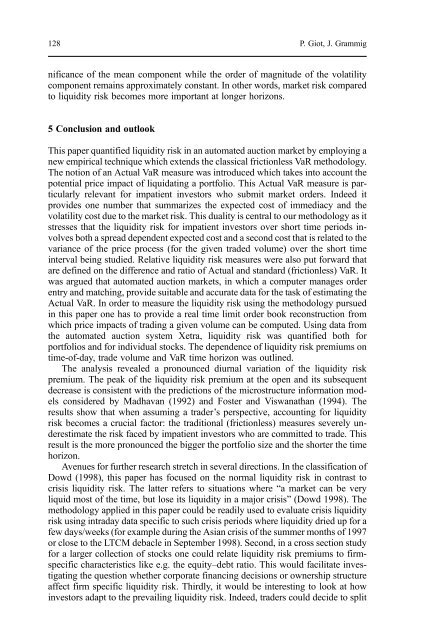recent developments in high frequency financial ... - Index of
recent developments in high frequency financial ... - Index of
recent developments in high frequency financial ... - Index of
Create successful ePaper yourself
Turn your PDF publications into a flip-book with our unique Google optimized e-Paper software.
128<br />
nificance <strong>of</strong> the mean component while the order <strong>of</strong> magnitude <strong>of</strong> the volatility<br />
component rema<strong>in</strong>s approximately constant. In other words, market risk compared<br />
to liquidity risk becomes more important at longer horizons.<br />
5 Conclusion and outlook<br />
P. Giot, J. Grammig<br />
This paper quantified liquidity risk <strong>in</strong> an automated auction market by employ<strong>in</strong>g a<br />
new empirical technique which extends the classical frictionless VaR methodology.<br />
The notion <strong>of</strong> an Actual VaR measure was <strong>in</strong>troduced which takes <strong>in</strong>to account the<br />
potential price impact <strong>of</strong> liquidat<strong>in</strong>g a portfolio. This Actual VaR measure is particularly<br />
relevant for impatient <strong>in</strong>vestors who submit market orders. Indeed it<br />
provides one number that summarizes the expected cost <strong>of</strong> immediacy and the<br />
volatility cost due to the market risk. This duality is central to our methodology as it<br />
stresses that the liquidity risk for impatient <strong>in</strong>vestors over short time periods <strong>in</strong>volves<br />
both a spread dependent expected cost and a second cost that is related to the<br />
variance <strong>of</strong> the price process (for the given traded volume) over the short time<br />
<strong>in</strong>terval be<strong>in</strong>g studied. Relative liquidity risk measures were also put forward that<br />
are def<strong>in</strong>ed on the difference and ratio <strong>of</strong> Actual and standard (frictionless) VaR. It<br />
was argued that automated auction markets, <strong>in</strong> which a computer manages order<br />
entry and match<strong>in</strong>g, provide suitable and accurate data for the task <strong>of</strong> estimat<strong>in</strong>g the<br />
Actual VaR. In order to measure the liquidity risk us<strong>in</strong>g the methodology pursued<br />
<strong>in</strong> this paper one has to provide a real time limit order book reconstruction from<br />
which price impacts <strong>of</strong> trad<strong>in</strong>g a given volume can be computed. Us<strong>in</strong>g data from<br />
the automated auction system Xetra, liquidity risk was quantified both for<br />
portfolios and for <strong>in</strong>dividual stocks. The dependence <strong>of</strong> liquidity risk premiums on<br />
time-<strong>of</strong>-day, trade volume and VaR time horizon was outl<strong>in</strong>ed.<br />
The analysis revealed a pronounced diurnal variation <strong>of</strong> the liquidity risk<br />
premium. The peak <strong>of</strong> the liquidity risk premium at the open and its subsequent<br />
decrease is consistent with the predictions <strong>of</strong> the microstructure <strong>in</strong>formation models<br />
considered by Madhavan (1992) and Foster and Viswanathan (1994). The<br />
results show that when assum<strong>in</strong>g a trader’s perspective, account<strong>in</strong>g for liquidity<br />
risk becomes a crucial factor: the traditional (frictionless) measures severely underestimate<br />
the risk faced by impatient <strong>in</strong>vestors who are committed to trade. This<br />
result is the more pronounced the bigger the portfolio size and the shorter the time<br />
horizon.<br />
Avenues for further research stretch <strong>in</strong> several directions. In the classification <strong>of</strong><br />
Dowd (1998), this paper has focused on the normal liquidity risk <strong>in</strong> contrast to<br />
crisis liquidity risk. The latter refers to situations where “a market can be very<br />
liquid most <strong>of</strong> the time, but lose its liquidity <strong>in</strong> a major crisis” (Dowd 1998). The<br />
methodology applied <strong>in</strong> this paper could be readily used to evaluate crisis liquidity<br />
risk us<strong>in</strong>g <strong>in</strong>traday data specific to such crisis periods where liquidity dried up for a<br />
few days/weeks (for example dur<strong>in</strong>g the Asian crisis <strong>of</strong> the summer months <strong>of</strong> 1997<br />
or close to the LTCM debacle <strong>in</strong> September 1998). Second, <strong>in</strong> a cross section study<br />
for a larger collection <strong>of</strong> stocks one could relate liquidity risk premiums to firmspecific<br />
characteristics like e.g. the equity–debt ratio. This would facilitate <strong>in</strong>vestigat<strong>in</strong>g<br />
the question whether corporate f<strong>in</strong>anc<strong>in</strong>g decisions or ownership structure<br />
affect firm specific liquidity risk. Thirdly, it would be <strong>in</strong>terest<strong>in</strong>g to look at how<br />
<strong>in</strong>vestors adapt to the prevail<strong>in</strong>g liquidity risk. Indeed, traders could decide to split










